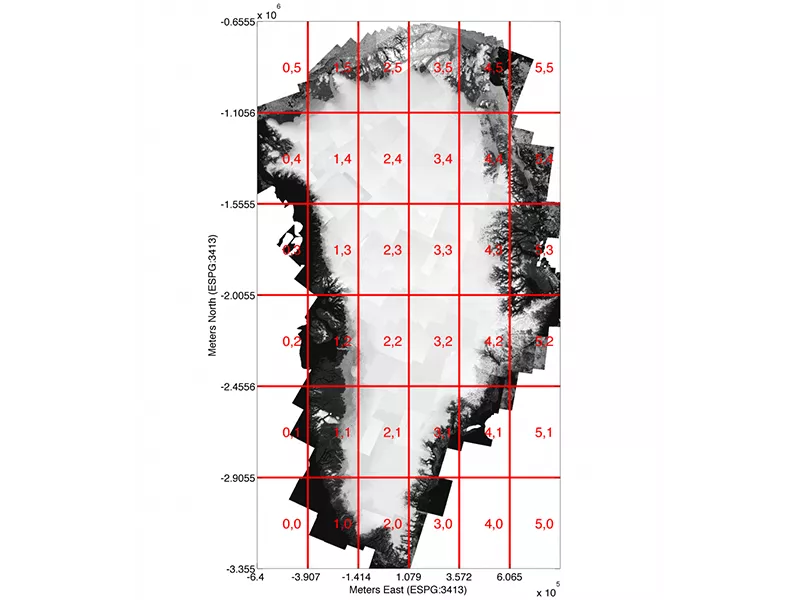
MEaSUREs Greenland Ice Mapping Project (GIMP) 2000 Image Mosaic, Version 1
Data set id:
NSIDC-0713
DOI: 10.5067/4RNTRRE4JCYD
This is the most recent version of these data.
Version Summary
Version Summary
Initial release
Overview
This data set, part of the NASA's Making Earth System Data Records for Use in Research Environments (MEaSUREs) program, provides a complete 15 m resolution image mosaic of the Greenland ice sheet, derived from USGS Landsat 7 ETM+ imagery and Canadian Space Agency's (CSA) RADARSAT-1 imagery from the years 1999 to 2002. Additional bands (some at 30 m resolution) are provided for each tile in the mosaic and are useful for understanding surface properties, such as snow grain size, bedrock outcrops, mapping layering in the snow, and blue ice or lake-filled regions, during the spring and summer months. The panchromatic (band 8) mosaic provides the highest-resolution view of the ice sheet surface at 15 m, resolving topographic features, large crevasses, and other geophysical structures.
See Greenland Ice Mapping Project (GIMP) for related data.
Parameter(s):
SURFACE MORPHOLOGY
Platform(s):
LANDSAT-7, RADARSAT-1
Sensor(s):
ETM+, SAR
Data Format(s):
GeoTIFF, ASCII
Temporal Coverage:
30 June 1999 to 4 September 2002
Temporal Resolution:
- 3 month
Spatial Resolution:
- 15 m
- 30 m
- 15 m
- 30 m
Spatial Reference System(s):
WGS 84 / NSIDC Sea Ice Polar Stereographic North
EPSG:3413
Spatial Coverage:
N:
82
S:
60
E:
-20
W:
-70
Blue outlined yellow areas on the map below indicate the spatial coverage for this data set.
Data Access & Tools
A free NASA Earthdata Login account is required to access these data. Learn More
Sample Data Image
Image

This image previews the mosaic of the Greenland Ice Sheet, acquired from 1992 to 2002. The overlying grid gives the tile identifiers. Credit: NASA MEaSUREs GrIMP Data: CSA, USGS
Documentation
Help Articles
How to Articles
Many NSIDC DAAC data sets can be accessed using the NSIDC DAAC's Data Access Tool. This tool provides the ability to search and filter data with spatial and temporal constraints using a map-based interface.Users have the option to
Below the image in this article, you will find sample code in IDL, MATLAB, and Python to read in a GeoTIFF file, extract the metadata, and create an image.
The code has been tested with the following data products:
We recommend using the Geospatial Data Abstraction Library (GDAL) to convert GeoTIFF files into a different format.
We recommend using the Geospatial Data Abstraction Library (GDAL) or a GIS to reproject geoTIFF files.
All data from the NASA National Snow and Ice Data Center Distributed Active Archive Center (NSIDC DAAC) is directly accessible through our HTTPS file system using Wget or curl. This article provides basic command line instructions for accessing data using this method.